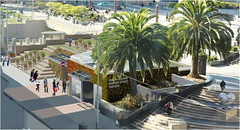Everything Old is Made New Again
Public transit is nothing new. The vehicles and modes may have changed, yet the idea is still the same. Transit gets the person from point A to point B and every other letter after that. Ideas thought to be antiquated and out-of-touch has begun to reemerge because their usefulness is being recognized by a new generation. This practice of historical recycling can also be seen within the public transit of San Francisco.
San Francisco Cable Cars, 1870s. Photo: San Francisco History Center, San Francisco Public Library
A person can be truly amazed at how big San Francisco’s transit system was at one point in the city. Cable cars – the iconic symbol of San Francisco – was invented by Andrew Hallidie and made its debut in 1873 on Clay Street. Hallidie designed the original cable car specifically for the hilly terrain that is inherent to San Francisco. Ten years after the first test run on Clay Street, cables cars could be seen running along Sutter, Geary, Market, Ellis, O’Farrell, Post, Powell, Sacramento, Washington, Jackson and Union Streets. The cable car began to be replaced by more transit efficient electric trolley cars in the late 1880s. San Francisco leaders never completely removed the cable cars because of the great love that the people of San Francisco had for them.
In the 1901 San Francisco transit statistics, there were 234 miles of track and 166 miles of overhead trolley line with 376 cable cars and 414 trolley cars in active service. Also in service, were 10 horse cars and 65 steam dummy cars that helped the cable and trolley cars accommodate the population of 342,782 people. Growth of transit continued in San Francisco with system lines that extended as far south as the City of San Mateo. From 1921 to 1944, most of San Francisco’s streetcar system was operated by the Market Street Railway. World War II brought increased ridership along with a dramatic growth in revenue that lead to the City of San Francisco’s purchase of the Market Street Railway.
With the advent of the personal automobile in society, there began to be a pulling away from light rail systems by both the city government and the public. Track systems that once sprawled throughout the city were either cutback or removed and replaced with bus lines or turned into roadways for automobiles. Today the transit community is moving to reclaim the auspicious heritage that was once in San Francisco. This will occur by building upon the remaining light rail lines that the San Francisco leaders had the good foresight to keep up and running.
Today there is a trend to provide transit environments that are both evolutionary as well as revolutionary. This can be seen in various transit projects across the United States as major cities have to adjust to growing populations and the need for better transit methods. Auto dependent cities such as Houston, Los Angeles and Phoenix have all realized the benefits of light rail. Even within San Francisco there is a move to expand transit operations as is seen with the Central Subway project and the rejuvenation of the Transbay Terminal. Technology in the present is able to improve upon the methods of the past by presenting options that were not available to our forefathers, such as advanced tunneling techniques and efficient electrical engineering. The progression of transit was just as vital back in the day as it is now and we are continually searching for ways and methods to make transit as accessible as it once was and will be.
Please check-in next week for our posting about the relationship between community development and public transit!








Excellent!
Great post! Just curious, though, how much surface rail could we build for $1.5 billion?